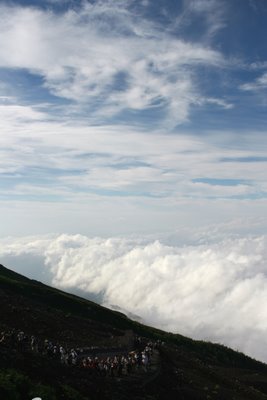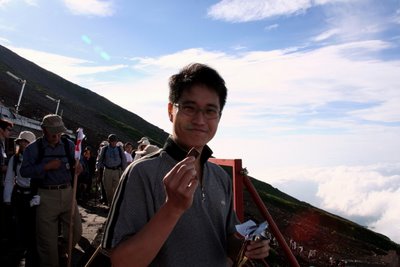 Completed the Mount Fuji climb on 23rd July - it was much tougher than expected, definitely not a normal 'tourist' activity. It's a task for which some physical and stamina training is greatly recommended, mainly because of the thin-air and terrain. I was lucky to have made it without any training, but just barely (totally exhausted by the end of the journey, and ankles/legs were aching badly... still having trouble climbing up and down the stairs for the next one week). Now I realized why I am the the first person (Japanese or non-Japanese) in my department who's doing the climb; most of them wished me 'good luck'/'all the best'/'come back in one piece' etc.
Completed the Mount Fuji climb on 23rd July - it was much tougher than expected, definitely not a normal 'tourist' activity. It's a task for which some physical and stamina training is greatly recommended, mainly because of the thin-air and terrain. I was lucky to have made it without any training, but just barely (totally exhausted by the end of the journey, and ankles/legs were aching badly... still having trouble climbing up and down the stairs for the next one week). Now I realized why I am the the first person (Japanese or non-Japanese) in my department who's doing the climb; most of them wished me 'good luck'/'all the best'/'come back in one piece' etc.
We took a bus to the 5th Station (at 1,500m above sea-level, about 40% up the mountain - serious mountaineers start the climb at 1st Station i.e. ground-level). Our equipment list as follows:- hiking boots (good old Timberlands - waterproof and made for battle); - 6 bottles of water (available for purchase on the mountain, but the price increases with altitude; up to $8 per bottle - the small 150ml ones!); - winter jacket/gloves (even during summer, the temperature can drop to near-freezing at the summit); - special 'rain hat' that bf bought the day before.. it looks like a fishing hat but made of plastic, and the front part of the shade is transparent, so that you can pull it over your eyes and look right through it, like a windshield, while your face is almost completely protected from rain; and - poncho/raincoat in case of wet weather.
 There were many climbers, mostly within the 20-40 yr range; but there were some kids and very senior folk (probably in their 70s) too; everyone was well-equipped with back-packs, colorful 'climbing suits' and walking/hiking sticks. This chap and his friends were video-recording their Ganbatte speech before the climb.
There were many climbers, mostly within the 20-40 yr range; but there were some kids and very senior folk (probably in their 70s) too; everyone was well-equipped with back-packs, colorful 'climbing suits' and walking/hiking sticks. This chap and his friends were video-recording their Ganbatte speech before the climb.
 At the waiting area just outside the entrance to the climbing trail, some of the 'climbing groups' had their leaders giving speeches, which usually ended with everyone shouting chants/slogans with raised fists (quite scary, like going to battle) - the Japanese take the Mt Fuji climb very seriously, since it's viewed as a sacred mountain, and climbing it is viewed as a form of pilgrimage. Of course, most of the tourists/westerners were standing around looking very quizzically at these activities, and taking pictures.
At the waiting area just outside the entrance to the climbing trail, some of the 'climbing groups' had their leaders giving speeches, which usually ended with everyone shouting chants/slogans with raised fists (quite scary, like going to battle) - the Japanese take the Mt Fuji climb very seriously, since it's viewed as a sacred mountain, and climbing it is viewed as a form of pilgrimage. Of course, most of the tourists/westerners were standing around looking very quizzically at these activities, and taking pictures.
 We started our climb at 2.30pm. The weather was mostly sunny with some cloud cover, and temperature ranging between 20 - 25 degrees. By 4.30pm we were above the clouds.
We started our climb at 2.30pm. The weather was mostly sunny with some cloud cover, and temperature ranging between 20 - 25 degrees. By 4.30pm we were above the clouds.

The higher we got, the tougher and steeper the terrain became - some areas had loose pebble-like gravel which made it hard to keep your footing, and other areas had black volcanic rock where each step forward was about twice the normal stair-case step-height; so it really was a 'climb' rather than an upslope walk. The air also got noticeably thinner; each time we had completed a section of the trail (the trail comprises a long zig-zag series of sections, about 3-5 persons wide, that snake up the mountain), we found ourselves huffing/puffing for air. Some of the climbers (mostly the older folk) brought along small oxygen tanks to 'oxygen-up' when they felt the need.

Pitstop on the mountain.
 Still at Level 7th, cloud was suddenly blown in.
Still at Level 7th, cloud was suddenly blown in.
 I think it is worth to climb Mount Fuji, unfortunately as I described my experiences to my colleagues, 9 out of 10 replied "I think I am more sure I dont wana do it now".
I think it is worth to climb Mount Fuji, unfortunately as I described my experiences to my colleagues, 9 out of 10 replied "I think I am more sure I dont wana do it now".
 One of the climbers in the tour group. Tour groups take frequent breaks and almost always jam up the mountain track coz they always climb very slowly.
One of the climbers in the tour group. Tour groups take frequent breaks and almost always jam up the mountain track coz they always climb very slowly.
Notice the slight agony in the smile...

Taxi on Mount Fuji

The march of the dedicated...Just keep walking, there is no turning back now...

At various points along the trail, there are 'mountain huts' where climbers can stay for the night, buy provisions (water, chocolate, food etc), use the bathroom, or just sit and rest before continuing the climb. The mountain was getting very crowded; often after we had made a rest stop, we had to queue up to join back the climbing trail. There must have been something in the order of tens of thousands of climbers that day.
 Two guys on the left.. checking their messages on their mobiles as they take a break. Indeed handphones are very vital to the Japanese.
Two guys on the left.. checking their messages on their mobiles as they take a break. Indeed handphones are very vital to the Japanese.
 Can anyone really resist the beauty Mount Fuji has to offer?
Can anyone really resist the beauty Mount Fuji has to offer?


















